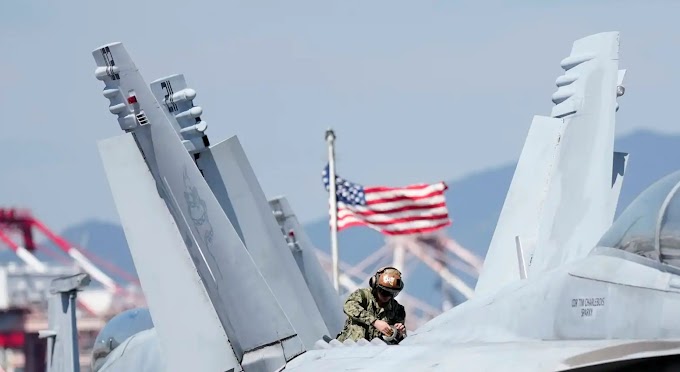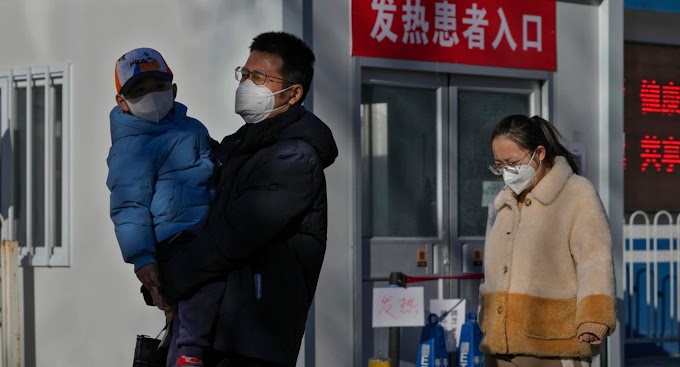PENTAGON- A senior Pentagon official who oversees Ukraine policy told Voice of America (VOA) on Thursday (Dec. 15) that there is a high level of urgency to provide advanced training for the Ukrainian military. The Pentagon announced that the United States will expand the number of Ukrainian troops it can train each month.
 |
| htened urgency for training ukrainis amid dynamic winter top pentagon |
Laura Cooper, deputy assistant secretary of defense for Russia, Ukraine and Eurasia, told VOA the skills of the Ukrainian military today are the same as when the U.S. first began training Ukrainian troops after Russia invaded Crimea in 2014 In comparison, it's a world of difference.
Earlier Thursday, Air Force Commodore Pat Ryder, the Pentagon press secretary, told reporters that starting in January, the United States would expand combat training, sending a larger, battalion-sized team to Germany every month Ukrainian troops provide advanced battlefield tactics training, including live-fire training.
This winter is going to be a very dynamic period, Cooper said in an exclusive interview with VOA. I think when some people think about winter, they think it's a period of remediation, but we don't see a slowdown in Ukraine. We certainly expect that the Russian side may try to push forward. The
United States has provided tens of billions of dollars in military support to Ukraine, ranging from the Stinger (Stinger) for infantry shoulders to the defense against short- and medium-range targets. Air defense systems including the National Advanced Surface-to-Air Missile System (NASAMS).
Voice of America reported this week, citing U.S. officials, that the U.S. was preparing to send a Patriot missile system to Ukraine to help shoot down incoming Russian missiles. Cooper would not confirm the news.
But I can confirm that air defense systems are our top priority and we are looking at a number of ways we can support Ukraine and its air defense needs. NASAMS is one of them, she said. She also added that U.S. assistance is constantly evolving to meet new battlefield needs.
Cooper also confirmed that the U.S. has shipped parts to Ukraine from an S-330 system to maintain Ukraine's air defenses until NASAM is deployed.
Last spring, we shipped parts to Ukraine to keep their S-300 system going. But with the NASAM system, which is really a top Western capability, Ukraine has always been able to use it, Very effectively against the threat of Russian missiles, as well as the threat of Russian unmanned aerial systems. The
The United States also helped persuade Slovakia to provide a complete S-330 system to the Ukrainian military in April this year, while the United States provided Slovakia with A Patriot missile system.
The U.S. currently has no plans to supply Ukraine with long-range precision munitions, including the Army Tactical Missile System (ATACMS) for Ukrainian rocket launchers. So far, the United States has provided the Ukrainian military with the Guided Multiple Launch Rocket System (GMLRS) for these launchers. ATACMS has a range of about 300 kilometers, while GMLRS has a range of about 90 kilometers.
At the moment, we think GMLRS is highly effective and can hit the large, large numbers of targets that Ukraine needs to hit. So we remain in GMLRS at the moment, she told VOA.
Referring to Russia's tactics in Ukraine, Cooper said Moscow was effectively throwing Russian forces into a meat grinder, with no regard for the very heavy casualties they faced.
Here's a full translation of the interview:
VOA: I wanted to start off by talking about the recently announced current facilities for training Ukrainian troops in Germany. I interviewed the Yavoriv training ground in Ukraine, so it sounds to me like the US was providing the same kind of training before the war broke out, is it basically the same thing this time?
COOPER: I think it's important to look at this training as a continuation of that training, and it's great that you've seen what we've done with some of our allies in Yaworif since 2014. But, at the same time, it's clear that today's context is very different. I mean, we've had very intensive training for the Ukrainian side on specialized weapons systems since February 24th. The United States and many of its allies in Europe are doing the same. We currently have a very strong UK-led training program in the UK. It's the personal training, so what they're doing is bringing those new recruits and recruits up to the level of competency required for combat operations. And then that adds to this battalion-level combined-arms training not only that the U.S. is going to provide, but also what the EU and other allies are providing. So, you're seeing Europe launching its group training programs with several EU countries, including Germany and Poland. When it comes to all these different efforts, it is important to know that they are all connected and coordinated. That's a role that the commander in European Command is playing to make sure we're all connected in support of Ukraine.
The Ukrainian army's ability and front are different.
VOA: Got it. So, what I'm hearing from you is that the training is similar but with a high level of urgency?
COOPER: High urgency and, you know, the Ukrainian armed forces are in a different situation. Their battlefield abilities are astonishing. When we think about when we and they started training in 2014, and when we think about their capabilities today, their ability to repel these Russian invaders, it's a world of difference.
VOA: Let’s talk about some of the $19 billion in military aid that has been sent to Ukraine since the war started. What do you think is the most effective weapon the Pentagon has provided to Ukraine?
COOPER: I think it's hard to name a specific weapon because as the battlefield evolves, so does our ability to provide the Ukraine with the assistance they need when they need it. So, in the early days after February 24th, when you saw the Russian side attacking Ukraine from multiple fronts, I think at that time, Javelin and Stinger were absolutely critical capabilities for the Ukrainian side to able to repel the initial advance and put the Russian offensive into a sort of freeze. Later, as the battlefield became more of an artillery battle in the east, it was the HIMARS system, and before that, our M777 howitzer played a very decisive role.
Why not provide long-range precision strike ammunition?
VOA: Now that you're talking about it, let's talk about Seamaster - High Mobility Multiple Launch Rocket System for our audience. The U.S. has so far provided GMLRS rockets with a range of about 90 kilometers, or 55 miles. But Ukraine has been hoping to get ammunition with a longer range, such as ATACMS. Is the Pentagon seriously considering supplying this ammunition? Do you foresee it being included in future military aid packages to Ukraine?
COOPER: We think it's important to say that we're always looking at the Ukrainian battlefield needs, we're always evaluating what's the best capability we can give them so they can meet their operational needs. At this moment, we believe that GMLRS is highly effective and can hit the large, large numbers of targets that Ukraine needs to strike. So we remain in GMLRS at the moment.
VOA: But some people will argue, and I talked to retired Lt. Gen. Ben Hodges, the former commander of the U.S. Army in Europe, who pointed out that ATACMS, which has a 300-kilometer range, would allow the Ukrainians to hit the Important parts of the Crimean Peninsula, they cannot reach with GMLRS. So, how do you respond to that? Isn't that the ability to be seen as a priority right now? What is the real reason for not providing this ammunition?
Cooper: You can't just look at this one ability. The Ukrainians have other capabilities that they can use to hit other targets, I think you've actually seen the strikes in Crimea, and speaking of which, you've seen the strikes in the Black Sea, there's a series of Ability. So again, I would say that we believe that the capabilities that we provide to Ukraine allow them to hit most of the targets that they need to hit for their operational purposes.
VOA: When I talk to people about long-range precision strike capabilities, I hear two different perspectives. One school of thought is that there is concern that Russia will see this as further escalation and will respond to it. The other school of thought is that long-range munitions are necessary because Russia has so far had safe havens on its own soil, and the Ukrainian side, with the exception we've seen in recent days, has yet to strike any Russian military or civilian capabilities. Where do you personally stand? What do you think of this debate?
COOPER: I think it's important not to talk about theoretical goals, to talk about theoretical responses, but to really focus on the Ukrainian battlefield needs. Just recently, you could tell their focus was on Kherson, and they pushed very effectively, pushing the Russian side back. Farther north at Kharkiv we saw them doing this, and now in Udon we see them fiercely resisting the Russian advance at Bakhmut. What capabilities do we consider their needs in these specific operational situations? What abilities are they using? Again, I would say that Seahorse, using GMLRS, has been very effective in taking out Russian command and control points, and key Russian logistics nodes, and enabling the Ukrainian side to not only hold but actually move forward.
VOA: My impression is that the British Secretary of Defense recently said that he was open to supplying Ukraine with longer-range weapons. What does the US Secretary of Defense think about this? What do you think about it? Or would you be open to discussing their needs with the Ukrainians in the future?
COOPER: Considering all the capabilities, we've been looking at what the Ukrainian side needs, and we've always been open to what that need might be.
VOA: So, yes, you all see the same thing.
Cooper: We've always been open to escalating demand.
Is it possible for the Russian army to attack again next year?
VOA: I want to talk to you about what the Ukrainian foreign minister said this month. He said that Russia's ability to launch a major offensive could be restored by January or February of next year -- that's the timeline. Is the United States also worried about this possibility? What is the Pentagon trying to do to prevent this from happening?
Cooper: We have been vigilant to observe where Russia may advance next, and what kind of combat operations they may be brewing. This winter will be a very dynamic time. I think when some people think of winter, they think of this as a downtime period, but we see no sign that the Ukraine side is going to slow down, and we certainly expect that the Russian side might try to push as well. Something to think about, though, is that the current situation in Russia is that their troops are in very bad shape. Many troops were hastily mobilized, received little training, were poorly equipped, and had extremely low morale. So while we're going to be very vigilant and we're going to look at supporting Ukraine with all the capabilities they need, we also recognize that Russia is struggling.
 |
| Voice of America's Pentagon correspondent Babb interviewed US Deputy Assistant Secretary of Defense Cooper. (December 15, 2022) |
VOA: Let’s talk a little bit about that. They were defeated again and again on the battlefield. So, as you foresee, as long as Ukraine continues to actively engage them, the Russians will not be able to regroup and re-offensive? Is my understanding correct? In this regard, can you explain what you think the Russian side will look like in the future? Because we know their current situation is bad, and morale is low, do you foresee this situation will continue until January next year?
COOPER: I think you have to look at both sides of the issue. On the one hand, is their brutal and heavy attack on Ukraine's civilian infrastructure. Obviously, the Russian side resorted to this tactic out of desperation, with no regard for the human rights of civilians or global public opinion. However, they seem to be maintaining this tactic. So, I think we can expect that Russia will continue to try to intimidate the Ukrainian civilian population and the Ukrainian government to bring them into submission to some extent. This is not going to happen. I think the Ukrainians are going to stand up, and with all this stuff that the United States and allies are delivering, both power equipment and air defense, they're going to be more resilient. At the same time, another aspect of Russian strategy has been to push their forces forward, trying to grab a little more territory by grudging. I certainly foresee them trying to keep doing that, but that's where their weaknesses -- their strength, their morale, their ability -- will hold them back. But the way Russia fights is not the way our allied armies or the Ukrainians fight, they actually throw their troops, throw their people into a meat grinder, regardless of the very heavy casualties they face.
VOA: Let’s talk about the Ukrainian Army’s ability to defend Ukraine’s civilian population. At present, the United States has only helped to provide Ukraine with two sets of NASAMS, which is the National Advanced Surface-to-Air Missile System. Can you tell us a little bit about the success of these systems? what are they doing I heard from an analyst that it was like 35 tries and 35 hits. Tell me what you heard from the battlefield.
Cooper: no problem. Again, I would say to put NASAMS in the larger context of air defense because we're looking at the whole picture of how we can make Ukraine's air defense capabilities, so we shipped zero to Ukraine as early as last spring components to keep their S-300 systems running. But with the NASAM system, this is really a top-level capability of the West. Ukraine has always been able to use it, and it is very effective in resisting the threat of Russian missiles and the threat of Russian drone systems. So, what we've seen, is they've been very successful in the last few waves of attacks, and again, Russia is trying to attack Ukrainian energy networks in these attacks, and they're failing.
Is it about delivering Patriots to Ukraine?
VOA: The Ministry of Defense of Ukraine recently expressed concern that they still cannot fully protect themselves from ballistic missile attacks, also known as Iskander ballistic missile attacks. That's what we heard -- two U.S. officials told VOA that the Pentagon is preparing to send Patriot missiles or Patriot missile systems to Ukraine to help them in that regard. Can you confirm that this is what the Pentagon is planning to do?
COOPER: I don’t have anything to announce to you right now in terms of new air defense capabilities, but I can confirm that air defense is our number one priority and we’re looking at a range of ways we can support Ukraine and its air defense needs. NASAMS is one of them. We're also talking to our allies, and we've had tremendous support from our allies in providing capabilities to Ukraine. Whether you're talking about Germany's IRIS-T system or a series of allies have been providing the fact that the NASAMS system launches the Advanced Medium-Range Air-to-Air Missile (AMRAAM).
VOA: The Counter Rocket, Artillery, and Mortar System (C-RAM) might be another option. Is this what the Pentagon is considering?
Cooper: I have no comment on that.
VOA: Well, I'm going to make it clear to our audience that we're not dwelling on the minutiae of weapon systems. Can you explain, should a Patriot missile system be sent to Ukraine? Can you talk a little bit about what kind of capabilities that will provide? Explain to our audience how the capabilities offered by this system differ from other systems that have shipped?
Cooper: I'm not a technologist who can go into the details of different systems, but I think what I can tell your audience is that air defense is not just about one system at one node. Air defense is about multiple systems that can target a range of threats, whether it's an Iranian drone purchased by Russia that threatens Ukrainian cities, or a cruise missile launched from land, air, or sea. You have to have multiple means of multiple systems to protect multiple nodes across the country.
Iran, China, and Russia
VOA: Now that Iran is mentioned, can you tell us what Iran is continuously offering to Russia? They have so far denied supplying weapons to Russia, but we can see fragments of Iranian drones used by Russia. So, is there any update on what and how many weapons they provided to Russia?
COOPER: Every one of these Iranian drones that threaten a Ukrainian city is another capability that Russia would not have had Iran not come to its aid. In fact, we have seen the damage caused by the drones, there are many eyewitness accounts from Ukraine, and we have seen them bravely shoot down these drones, even with the machine guns that we provide them, so Iran is indeed in Continue to provide these drones to the Russian military. We know that during the war in Ukraine there were significant developments in relations between Iran and Russia.
VOA: Do you see Russia being able to replace some of the equipment they lost? Are they really suffering from severe attrition at this moment?
COOPER: I think we've seen the Russian defense industry falter. Export controls by the United States and its allies have helped starve the Russian defense industry of the supplies it depends on. At the same time, I know that Russia is trying to find additional sources of supplies. They're trying to figure out how to produce or source. But at the moment, we know, they're in trouble because the two friends they're looking for seem to be Iran and North Korea, and they lack other suppliers.
VOA: At the moment you still don't see any support from China?
Cooper: In terms of support from China, I don't have any information.
Will it supply Ukraine with Western fighter jets and main battle tanks?
VOA: Alright. Then I want to ask another question about the weapons that the United States has been providing. What we haven't seen so far are jet fighters. Is this under consideration, and if not, why?
COOPER: Again, there's a whole range of capabilities to look at, and we're open to that, but our focus has really been on what the Ukrainian side can use right now? We know they need air defense now. So we've largely focused our focus here. We know they need firepower, long-range firepower, artillery, including Seahorse, and ammunition to support them. We know they need armored vehicles in order to move. So these kinds of capabilities are something we're very, very focused on. In the air, we've been focusing on drones that can deploy very quickly and can effectively disrupt Russian positions. In terms of aircraft, the Ukrainian side has clearly shown that they are capable of operating, their MiGs have been in the war, so we have decided to further enhance the capabilities of their MiGs, for which we have provided them with these high-speed anti-radiation missiles (HARM), the anti-radiation missiles we supplied to Ukraine have already played a role. We also provided a lot of parts to help keep these MiGs flying. It's all about acquiring capabilities that you can use right away, not capabilities that require a lot of training, a lot of maintenance work.
VOA: That's what critics say about Patriots, too. From what I understand, someone needs at least six months of training to use a Patriot. NASAMS used it for months, right? It took at least two months.
Cooper: To be honest, I don't remember exactly how long it took. But what I mean is that there are real training challenges for most Western air defense systems. But you know, we take that into account when we deliver all those systems to Ukraine. We ensure that we have this capability, we have corresponding training, and we have corresponding maintenance support capabilities. So, you know, when we made that commitment, they knew it was a commitment to the full suite of systems.
VOA: You mentioned armored vehicles, and the US provided Russian-made armored vehicles. But so far, I have not seen any M1A1 Abrams tanks being delivered to Ukraine, which some say will give them a huge battlefield advantage. Will the United States send such weapons? In other words: why hasn't the US sent any US-made M1A1s into combat yet?
COOPER: Again, we're looking at what they need and what they're able to use right now. We, therefore, offer a range of various armored vehicles, including the armored Humvee. And the M115, are armored personnel carriers that give the Ukrainian side both mobility and protection during counter-offensive operations. So, that's something that we've made a priority and they've used it successfully. As for the tanks, our priority is to help convert or encourage donations of Soviet-era tanks, because we've seen them being used very, very effectively by the Ukrainian side. We know they can be deployed immediately, and maintenance support is relatively straightforward. The Ukrainian side is very capable in this regard. Western-style tanks will take longer, not only for training but also for a more complex and challenging maintenance support system, which will not happen in the near future.
Russian nuclear threat
VOA: Next I want to make a final comment on the potential threat from Russia. In many ways, Ukraine is fighting for the West, fighting for democracy, fighting for sovereignty, not letting someone invade, and bullying another sovereign country. One looming threat, however, is the nuclear threat. However, now that the war has entered its tenth month, there have been some remarks that some of the Pentagon said were irresponsible. Where do you think Russia is currently in terms of nuclear threats? Do you think this is still a very real threat? Or do you side with a lot of analysts who don't think nuclear weapons have any tactical advantage on the battlefield at this moment, so they don't think Russia will use them?
COOPER: What I will tell you is that this is something that we look at every day, really every day. We're looking at Russia's nuclear bloc. See if there's any sign they're mobilizing or working on any readiness builds, or eventually strikes. We see no sign that Russia is doing anything out of the ordinary when it comes to its nuclear bloc. But we stay tuned. In terms of Russian intentions, it's hard to say. Of course, it's hard to get inside Vladimir Putin's head to see what he's thinking, but on the nuclear issue, what we've seen from Moscow is really a lot of irresponsible threats of force aimed at intimidation, but is not associated with any specific action.
Will the United States continue to aid Ukraine?
VOA: A new Congress is about to take office. Do you foresee any changes in US aid to Ukraine? Should Ukraine expect a new aid package soon?
COOPER: I'm delighted to have incredible bipartisan support in terms of supporting Ukraine. In the U.S. Congress, there is really bipartisan support. I foresee continued strong support from the United States Congress. Of course, it's a conversation, it's a process, and we're accountable to Congress in terms of the aid that they're funding. But I foresee strong support. Everything I hear from members of Congress is that they want Ukraine to have the capabilities they need when they need them. So, we are united on this one.
VOA: So, can you tell VOA’s Ukrainian audience that no matter how long it takes, as long as they’re in this war, this administration will keep their promises to them.
COOPER: What I’ve heard from every American leader, whether it’s Secretary Austin or President Biden himself, is that we’re going to support Ukraine for as long as it takes.








